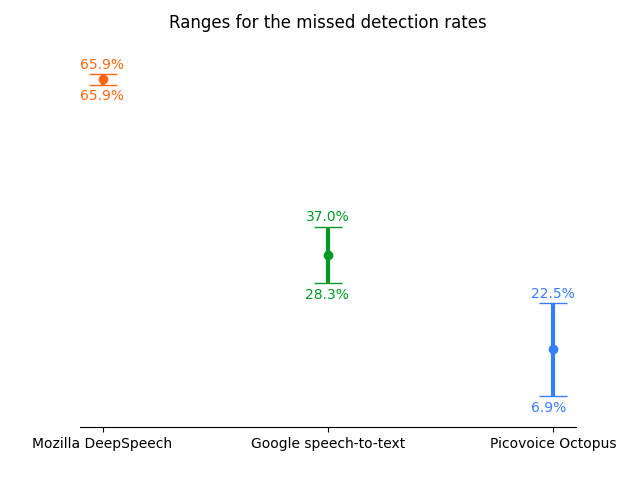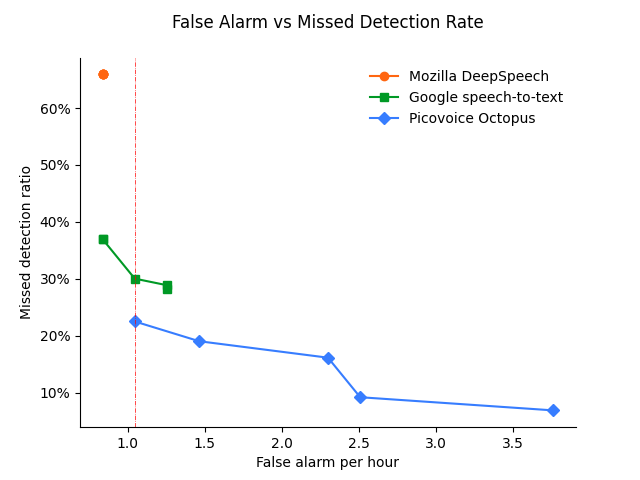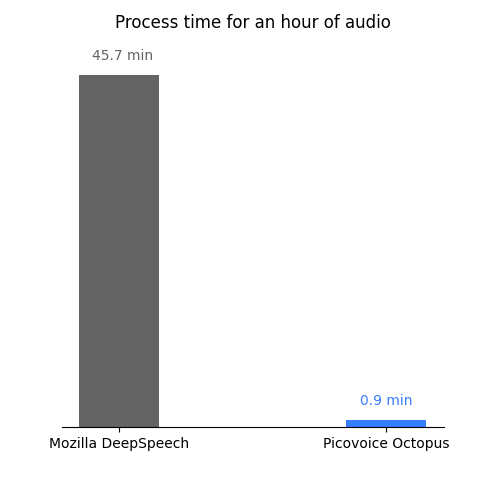Speech-to-Index Benchmark
Made in Vancouver, Canada by Picovoice
This is a minimalist and extensible framework for benchmarking different Speech-to-Index engines. It has been developed and tested on Ubuntu 20.04 (x86_64) using Python3.8.
Table of Contents
Background
This framework has been developed by Picovoice as part of the Octopus project. Octopus is Picovoice's Speech-to-Index engine. It directly indexes speech without relying on a text representation.
Data
TED-LIUM Release 3 dataset is used for benchmarking.
Metrics
This benchmark mainly considers three metrics: missed detection rate, false alarm per hour, and real-time factor.
Missed Detection rate and False Alarm Per Hour
We measure the accuracy of the Speech-to-Index engines using false alarm per hour and missed detection rate. The false alarm per hour is measured as a number of false positives in an hour. Missed detection is measured as the percentage of search phrases inside an audio file that an engine misses incorrectly.
Real Time Factor
Real time factor (RTF) is measured as the ratio of CPU (processing) time to the length of the input speech file. An engine with lower RTF is more computationally efficient. We omit this metric for the cloud-based Google speech-to-text engine.
Engines
Since Octopus has no exact off-the-shelf counterpart that can search through audio files by indexing them, we use two well-known speech-to-text engines to transcript audio files first and then search inside the obtained text-based results.
Google speech-to-text
A cloud-based speech recognition engine offered by Google Cloud Platform. Find more information here.
Mozilla DeepSpeech
Mozilla DeepSpeech is an open-source implementation of Baidu's DeepSpeech by Mozilla.
Picovoice Octopus
Octopus is a Speech-to-Index engine developed using Picovoice's proprietary deep learning technology, which directly indexes speech without relying on a text representation. It works offline and is supported on a growing number of platforms including Android, iOS, and web.
Usage
Below is information on how to use this framework to benchmark the mentioned engines.
- Make sure that you have DeepSpeech installed on your machine by following the instructions on its official pages.
- Install all required python packages by runnig
pip3 install -r requirements.txtinside the terminal - Run the
config.pyscript in order to download and unpack DeepSpeech's models under resources/engines/deepspeech. - Download TED-LIUM Release 3 and unpack it on your computer.
- For running Google speech-to-text, you need to sign up and setup permissions / credentials according to its documentation. You also need to enable the 'Cloud speech-to-text' and 'Cloud storage' APIs and create a bucket for this benchmark. Running these services may incur fees.
- For running Octopus, you need to get an
AccessKeyfrom the Picovoice Console.
Missed Detection Rate and False Alarm Per Hour Measurement
These two metrics can be measured by running the following command from the root of the repository:
python3 benchmark.py --engines {ENGINES} --dataset_folder {DATASET_FOLDER} --access_key {ACCESS_KEY} --google_bucket_name {GOOGLE_BUCKET_NAME}where {DATASET_FOLDER} is the path to the folder in which the TEDLIUM
dataset is extracted. The valid options for the {ENGINES}
parameter are: MOZILLA_DEEP_SPEECH, GOOGLE_SPEECH_TO_TEXT, and PICOVOICE_OCTOPUS. {ACCESS_KEY} or {GOOGLE_BUCKET_NAME} should be entered as the input only if the selected engine is Octopus or Google speech-to-text respectively.
Real Time Factor Measurement
Make sure all the git submodules are updated. Then, run the following command:
python3 realtime_factor.py --dataset_folder {DATASET_FOLDER} --access_key {ACCESS_KEY}Results
The benchmarking was performed on a Linux machine running Ubuntu 20.04 with 16GB of RAM and an Intel i7-10710U CPU running at 4.7 GHz.
The figure below compares the upper and lower ranges of the missed detection rates for all engines.
The figure below shows the false alarm per hour versus the missed detection rate at different confidence levels. Mozilla DeepSpeech does not provide the confidence level of the result in the same way that other engines deliver. Therefore, there is only one data point for it in the plot instead of a curve.
In addition, as shown by a red line at around 1 false alarms per hour, Octopus achieves 22% for the missed detection rate while Google speech-to-text achieves 30%.
The figure below depicts the time an engine requires for processing an hour of audio.


